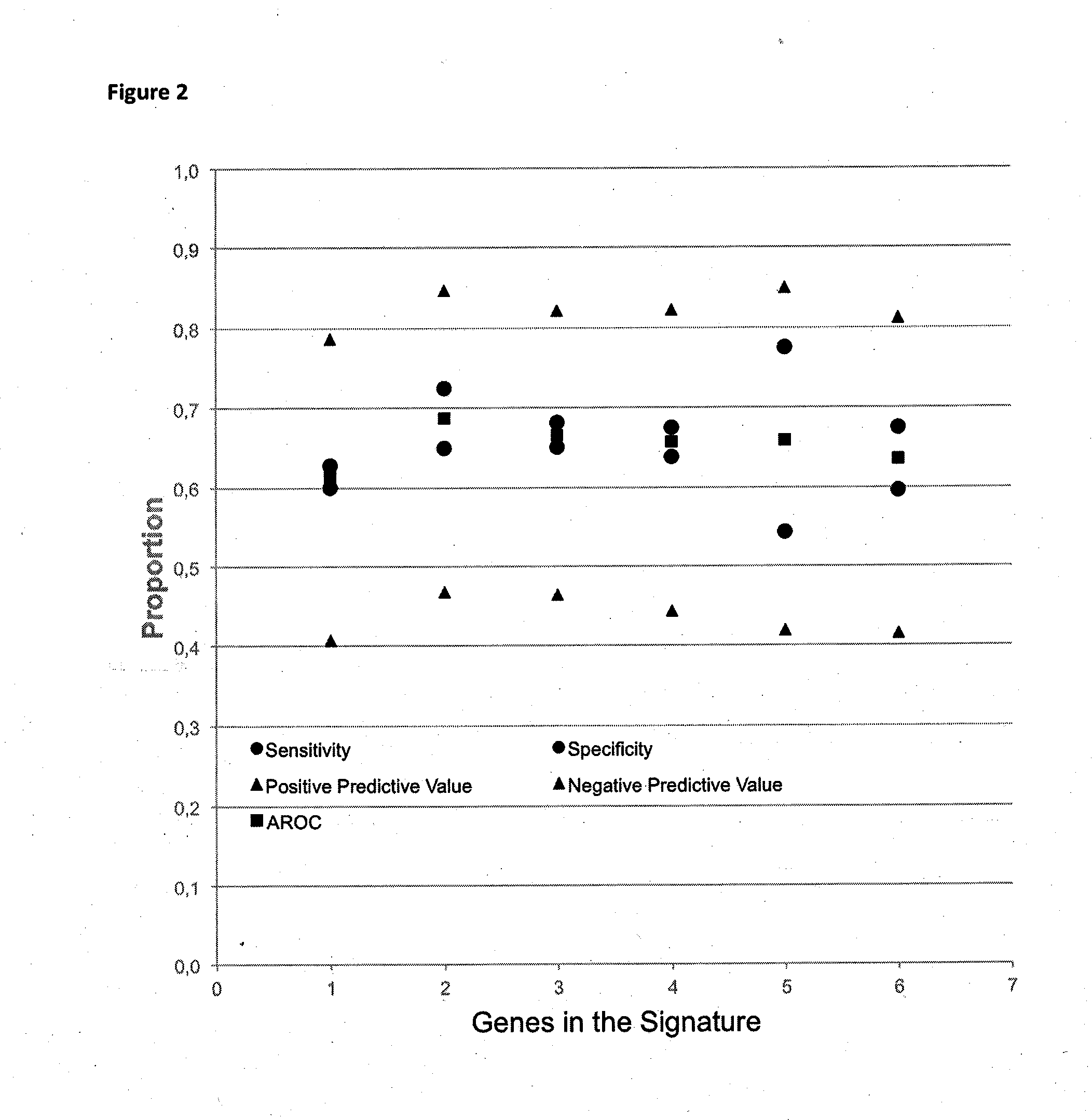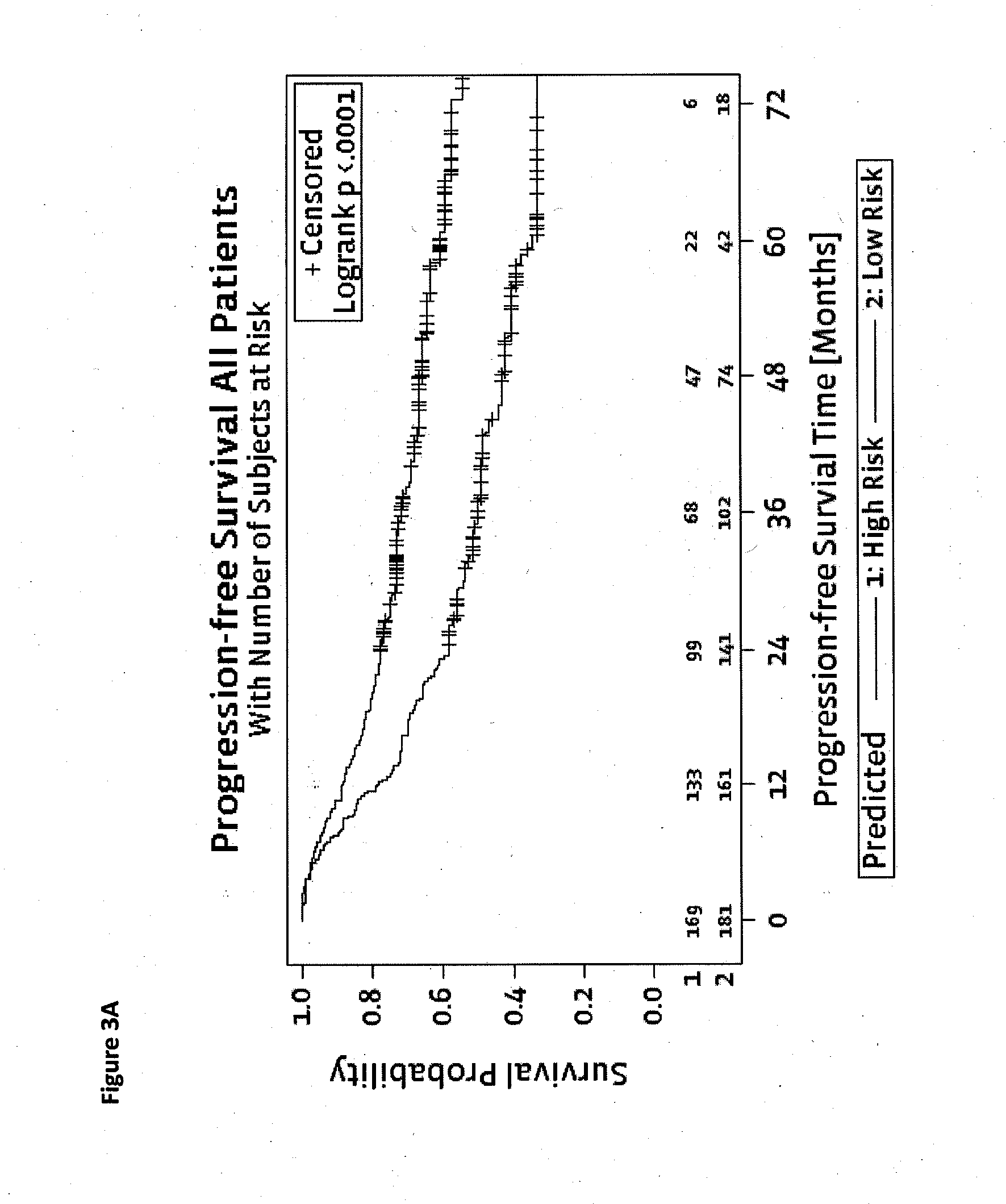Method for predicting a manifestation of an outcome measure of a cancer patient
a cancer patient and outcome measure technology, applied in the field of methods for predicting the manifestation of an outcome measure of a cancer patient, can solve the problems of adjuvant chemotherapy, poor patient outcome, and large number of patients who will die relatively quickly
- Summary
- Abstract
- Description
- Claims
- Application Information
AI Technical Summary
Benefits of technology
Problems solved by technology
Method used
Image
Examples
example 1
A Missense Sequence Variations Only
[0124]Table 9 shows prediction functions and their performance based on sequence variations of one gene only.
[0125]Mutations: N1=396, N2=296
[0126]Minimum 2 Patients mutated in any given cancer gene
[0127]N=134, 40 Patients with Metastases, 94 Patients with no Recurrence
[0128]As can be seen in Table 9, !TP53 is the strongest single marker followed by KRAS and !APC, if optimization is performed for AROC (area under the curve). !TP53 is the strongest single marker followed by KRAS and PIK3CA if optimization is performed for combined Jaccard ratio. Preferred are prediction functions that comprise !TP53 or its equivalent TP53.
[0129]Table 10 shows the performance of prediction functions for 1 to 6 genes, based on missense mutations only.
[0130]As can be seen in Table 9, !TP53 has the largest single impact. The second best marker is XOR BRAF or its logic equivalence XOR !BRAF. The third best marker is OR SMO or ist logic equivalent. The fourth, fifth and si...
example 18
Missense and Nonsense Sequence Variations Only
[0135]Mutations N1=354; N2=465
[0136]Table 12 shows preferred prediction functions based on missense and nonsense sequence variations only and their clinical performance (sequence variations N1=354; N2=465), Performance of Best One to Six Genes.
[0137]As can be seen in Table 12, adding further genes up to 8 does not change performance of a function. Adding more than 8 sequence variation statuses leads to a decrease of performance.
[0138]Table 13 shows further preferred prediction functions for determining progression of disease in Stage II Colorectal Cancer as an outcome measure. The addition of nonsense sequence variations does not change the structure of the signatures, as there are only 42 additional sequence variations and preferentially only in TP53 and APC.
example 1c
Missense and Nonsense and Silent and Synonymous Mutations Only
[0139]Mutations N1=1044; N2=800
[0140]Table 14 shows preferred prediction functions based on missense and nonsense and silent and synonymous sequence variations Only (sequence variations N1=1044; N2=800) and their performance.
[0141]Table 15 shows further preferred prediction functions based on missense and nonsense and silent and synonymous sequence variations Only (sequence variations N1=1044; N2=800) and their performance.
[0142]As can be seen, the use of missense sequence variations for predicting progression of disease is preferred in this example. Nonsense mutations add a little in performance, especially regarding specificity. Silent and synonymous sequence variations in functions do not add performance to functions of missense mutations alone. A function length of between 1 and 6 sequence variation statuses is preferred.
[0143]Table 16 shows best performing functions with missense and nonsense sequence variations and ...
PUM
| Property | Measurement | Unit |
|---|---|---|
| Fraction | aaaaa | aaaaa |
| Fraction | aaaaa | aaaaa |
| Shrinkage | aaaaa | aaaaa |
Abstract
Description
Claims
Application Information
 Login to View More
Login to View More - R&D
- Intellectual Property
- Life Sciences
- Materials
- Tech Scout
- Unparalleled Data Quality
- Higher Quality Content
- 60% Fewer Hallucinations
Browse by: Latest US Patents, China's latest patents, Technical Efficacy Thesaurus, Application Domain, Technology Topic, Popular Technical Reports.
© 2025 PatSnap. All rights reserved.Legal|Privacy policy|Modern Slavery Act Transparency Statement|Sitemap|About US| Contact US: help@patsnap.com



